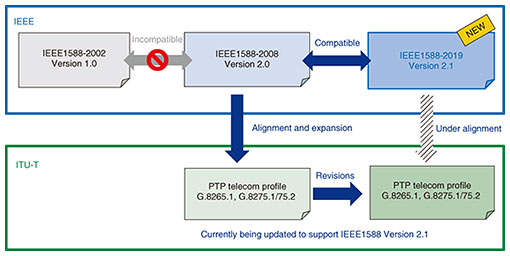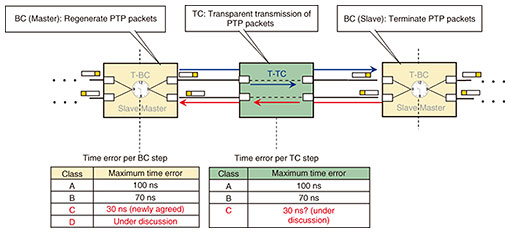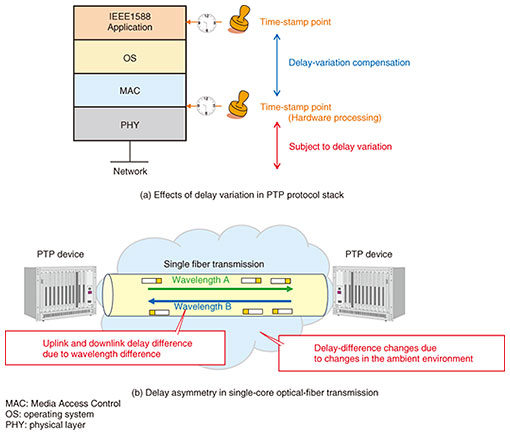 |
|||||||||||||||||||
|
|
|||||||||||||||||||
|
Global Standardization Activities Vol. 19, No. 12, pp. 85–92, Dec. 2021. https://doi.org/10.53829/ntr202112gls High-accuracy Time-synchronization Technology for Low-latency, High-capacity Communications in the 5G and Beyond 5G erasAbstractHigh-accuracy time-synchronization technology has been attracting attention for enabling services that use high-accuracy time information, such as fifth-generation (5G) mobile communications, high-frequency financial transactions, high-definition video distribution, and smart grids. The International Telecommunication Union - Telecommunication Standardization Sector (ITU-T) Study Group (SG) 15 and the Institute of Electrical and Electronics Engineers (IEEE) mainly carry out international standardization. In this article, we introduce the time-synchronization requirements for 5G as well as next-generation communication technologies, such as Beyond 5G and quantum communications, an overview of time-synchronization technology/Precision Time Protocol (PTP), the standards of which have recently been updated by IEEE, and the latest discussion topics in ITU-T SG15. Keywords: time synchronization, PTP, 5G/Beyond 5G 1. Background of time-synchronization technologyTime synchronization means that the time between systems in a communications network is the same and is consistent with Coordinated Universal Time (UTC). Time synchronization is required for fourth-generation (4G) and later mobile communications, and technology has been developed to deliver UTC-synchronized time information to mobile base stations. As information technology (IT) services have become more diversified and higher quality, the application of time information has expanded beyond the mobile field. Examples include high-accuracy time stamping in high-frequency trading in the financial sector, synchronization in distributed processing among datacenters, frame synchronization in video streaming, and time synchronization among instruments in large-scale scientific experiments such as accelerators in atomic physics. Time-synchronization technology plays an important role in various industries and scientific fields, as described above, is discussed in many forums and standardization organizations, and is being commercialized and introduced into services. The International Telecommunication Union - Telecommunication Standardization Sector (ITU-T) has been discussing the requirements for time synchronization in communication networks and specifications for high-accuracy time-synchronization devices. 2. Use cases and requirements of time synchronization in telecommunicationsWe first introduce the use cases of time synchronization in telecom networks that are under consideration by ITU-T and example requirements for mobile and industrial applications. In 4G and later mobile communications, the same frequency is time-shared and transmitted for both uplink and downlink communications (i.e., time division duplex (TDD)) to effectively use the bandwidth of mobile base stations. For TDD, a time-synchronization accuracy of +/–1.5 µs is required. However, to maximize the use of the radio frequency band allocated to each telecom operator in 4G/5G communications, a system without inter-operator guard bands is used. Therefore, if the time-synchronization error increases, there are concerns about radio-wave interference between operators (Fig. 1(a)). This suggests that if the time error between certain operators increases, the uplink and downlink frame patterns may be reversed, and interference may occur with other neighboring operators (Fig. 1(b)). In Japan, 4G and later operate without guard bands; hence, there are concerns about the effects of interference due to time-synchronization errors [1]. To avoid this problem, it is necessary to synchronize to a common time standard (e.g. GPS (Global Positioning System)) among operators and unify the uplink and downlink TDD frame structure. NTT clarified these interference mechanisms and detailed conditions of their occurrence due to time-synchronization errors, proposed consideration of them in ITU-T Study Group (SG) 15, and reflected them in requirements for time synchronization in Recommendation G.8271 at the January 2020 meeting.
The Institute of Electrical and Electronics Engineers (IEEE) has standardized time-sensitive networking (TSN) as an industrial Ethernet standard to enable real-time monitoring and control with low latency and time synchronization and has specified standards for time synchronization in IEEE802.1AS. One proposed use case is to transmit time information over the 5G network of a telecom operator and deliver it to industrial applications assumed for TSN (Fig. 2). At the ITU-T SG15 meeting in April 2021, a budget of 900 ns was proposed as the time accuracy required for the 5G network specified by ITU-T. Details of the requirement will be discussed in the future.
As future use cases of time synchronization, applications to next-generation communications, such as quantum communications and quantum cryptography, are also being studied. In ITU-T, standardization of quantum key distribution (QKD) is actively being discussed. One of the methods of QKD requires high-accuracy time synchronization to detect weak photon signals from the sender at the receiver with accurate timing. Certain telecom operators are also interested in time synchronization in QKD, and requirements for synchronization technologies for these systems are expected to be discussed in the future. 3. Enhancement of time synchronization—New PTP standardsNext, we introduce trends in Precision Time Protocol (PTP), which is a protocol to achieve high-accuracy time synchronization. PTP synchronizes time between two systems by exchanging dedicated packets that are embedded time information [2]. The basic PTP has been standardized as IEEE1588. On the basis of IEEE1588, standardization organizations and research institutes in various industrial fields maintain compatibility and extend the protocol according to requirements for various usage scenes (Fig. 3). The ITU-T supervises the communications field and defines PTP specifications for communications networks to meet requirements of the mobile applications discussed in the 3rd Generation Partnership Project (3GPP). IEEE supervises the industrial field and is expected to support private 5G*1 by using the TSN standards mentioned earlier.
The current PTP was standardized as IEEE1588-2008 (Version 2.0) in 2008. Its extended specification was standardized as PTP telecom profile by ITU-T. It was then introduced to commercial communication devices and deployed to telecom networks worldwide. A new standard was also completed as IEEE1588-2019 (Version 2.1) and released in 2020 [3]. Version 2.1 is backward compatible with Version 2.0, although the standard documentation has been significantly increased from about 300 pages in Version 2.0 to about 500 pages in Version 2.1 as many new functions have been incorporated. In response to the increasing importance of time synchronization in applications and the emergence of high-accuracy time-synchronization requirements in various fields, IEEE1588-2019 was expanded from the previous PTP standards mainly in terms of flexibility, robustness, and accuracy (Table 1). Regarding flexibility, the PTP packet forwarding method allows both unicast and multicast packets to be mixed. In terms of robustness, features related to security functions, quality monitoring of PTP receiving ports, and redundancy of PTP domains*2 were added to enhance the protocol’s resistance to abnormal operations. Accuracy has been improved from the nanosecond level to sub-nanosecond (in the order of 0.1 ns) level, and a calibration function was added for optical path differences between uplink and downlink of optical fibers and time-stamp errors between egress and ingress in a PTP device, which affect synchronization accuracy. To achieve compatibility between IEEE1588-2019 and the PTP telecom profile, ITU-T is in the process of updating the recommendations (Fig. 4). A number of telecom profile parameters were added and modified to comply with IEEE1588-2019 at the April 2021 meeting.
4. Improving the accuracy of time synchronization—PTP devicesITU-T has been studying to improve the accuracy of PTP devices to meet the requirements of 5G and is still discussing how to further improve the accuracy. ITU-T specifies a telecom-boundary clock (T-BC) in G.8273.2 as a device that transmits time information over a network using PTP [2]. The T-BC terminates PTP packets and relays them to the next device (Fig. 5). The maximum absolute time error per T-BC was specified as Class B at 70 ns, but then a new standard was newly specified as Class C at 30 ns. Class D regulations to achieve even higher accuracy have also been under discussion from 2019 onwards. The telecom-transparent clock (T-TC), which transmits PTP packets transparently without terminating them, is defined in G.8273.3 (Fig. 5). For T-TC, discussions on high-accuracy classes after Class C have also begun, and certain Class C error parameters have been agreed at the September 2020 meeting. The maximum absolute time error has not yet been specified, but there is a proposal to set it to 30 ns, which is equivalent to T-BC Class C. This is expected to be discussed in the future.
5. Improving the accuracy of time synchronization—Delay measurementSince PTP is a protocol in which uplink and downlink latencies are assumed constant, ITU-T SG15 has been actively discussing delay of a PTP device and optical-fiber propagation delay, which are the main causes of synchronization-accuracy degradation. Regarding delay of a PTP device, ITU-T is concerned about the effect of processing-delay variations at lower layers that cannot be eliminated by the hardware-timestamping function specified in IEEE1588 (Fig. 6(a)). There is an opinion that the time of delay should be specified with nanosecond accuracy for data processing at the physical layer in optical modules. It has also been pointed out that the delay variation in frame multiplexing and forward error correction (FEC) in digital signal processing used for optical signal transmission and reception is several tens of nanoseconds. Since the delay variation of a device is directly related to the time errors of PTP, a clear specification of the fixed delay and control of the variation are required. However, there is also the dissenting opinion that it is difficult to specify the fixed delay of the optical module configurations and FEC processing as a standard because of the dependency on system-vendor implementation. These issues are therefore currently under continuous study. Regarding optical-fiber propagation delay, the delay difference between an uplink and downlink of less than 1 ns must be measured for a route of PTP packets. In optical-fiber propagation delay, the optical-path-length variation caused by the refractive index change and mechanical expansion and contraction of the optical fiber when the ambient temperature changes must be considered. The calibration function of the difference in delay specified in IEEE1588-2019 is based on the assumption that PTP devices are directly connected by optical fibers and that there is no change in difference of delay during operation. However, considering complex telecom networks, the need to dynamically measure delay differences with high accuracy has been raised in ITU-T. In particular, the coherent network Primary Reference Time Clock (cnPRTC)*3 [4], which is a concept for high-accuracy time-generation architecture that NTT has proposed and standardized jointly with other telecom operators, uses a network to connect distributed PRTC devices (time-reference devices) and compare their time information. At the April 2021 meeting, it was agreed that requirements of the time-transmission accuracy for the comparison link between PRTCs should be very high—Class A: 5 ns, Class B: 1 ns. In Class B, PTP packet transmission is presumably executed using a single optical fiber for bi-direction. Since uplink and downlink PTP packets are transmitted at different wavelengths on a fiber, there are wavelength-dispersion effects in which optical-fiber propagation delay varies depending on the wavelength (Fig. 6(b)). To address this, experts in various technical fields are also jointly discussing technologies to accurately measure optical-fiber propagation delay. Such delay can generally be measured using optical time-domain reflectometry (OTDR)*4. The use of correlation OTDR, which enables high-accuracy measurement by modulating optical pulses and correlating them at the receiver, is also under discussion. However, issues remain such as the effect of the differences between the OTDR measurement wavelength and PTP transmission wavelength and how to deal with a case making it impossible to secure the reflection path of optical pulses because of optical amplifiers deployed along the section to be measured.
6. Future synchronization technologiesAs a synchronization signal reference, the use of optical clocks*5 is being considered as next-generation high-accuracy atomic clocks to replace the conventional cesium atomic clocks. Optical clocks are expected to surpass commercial cesium atomic clocks in accuracy by more than five orders of magnitude and are attracting attention as a new standard of seconds for the future. In ITU-T SG15, proposals have begun for new work items such as a new time-synchronization method using UTC-synchronized optical clocks as a time source and monitoring of operational cesium atomic clocks with high-accuracy optical clocks. NTT has proposed a next-generation synchronization network concept based on optical clocks and will continue to actively propose requirements for next-generation synchronization devices and networks.
7. Future developmentsThe use of 5G and Beyond 5G networks will be expected to diversify, and many IT services using highly accurate time information will emerge in the future. NTT will continue to actively contribute to the standardization of synchronization technology by searching for potential service requirements and monitoring the latest technological developments. References
|
|||||||||||||||||||

















